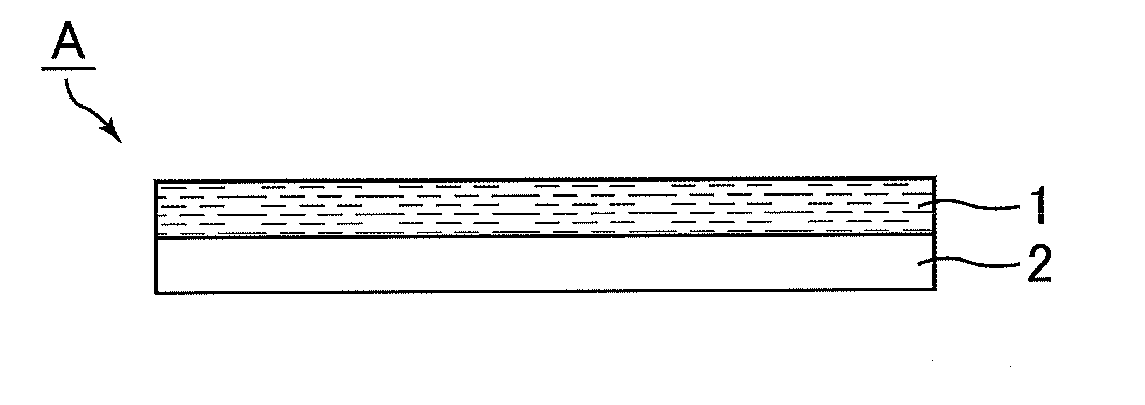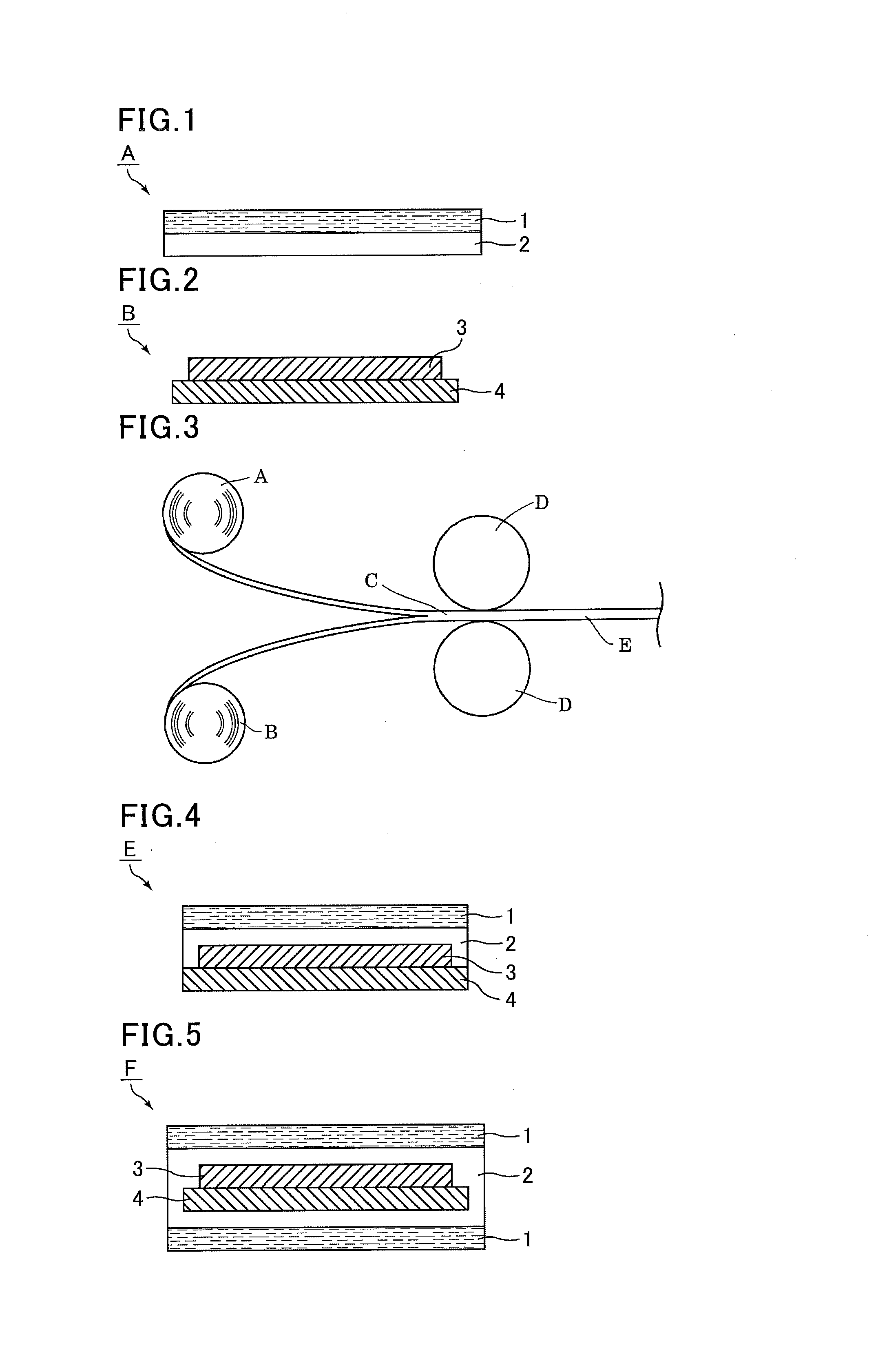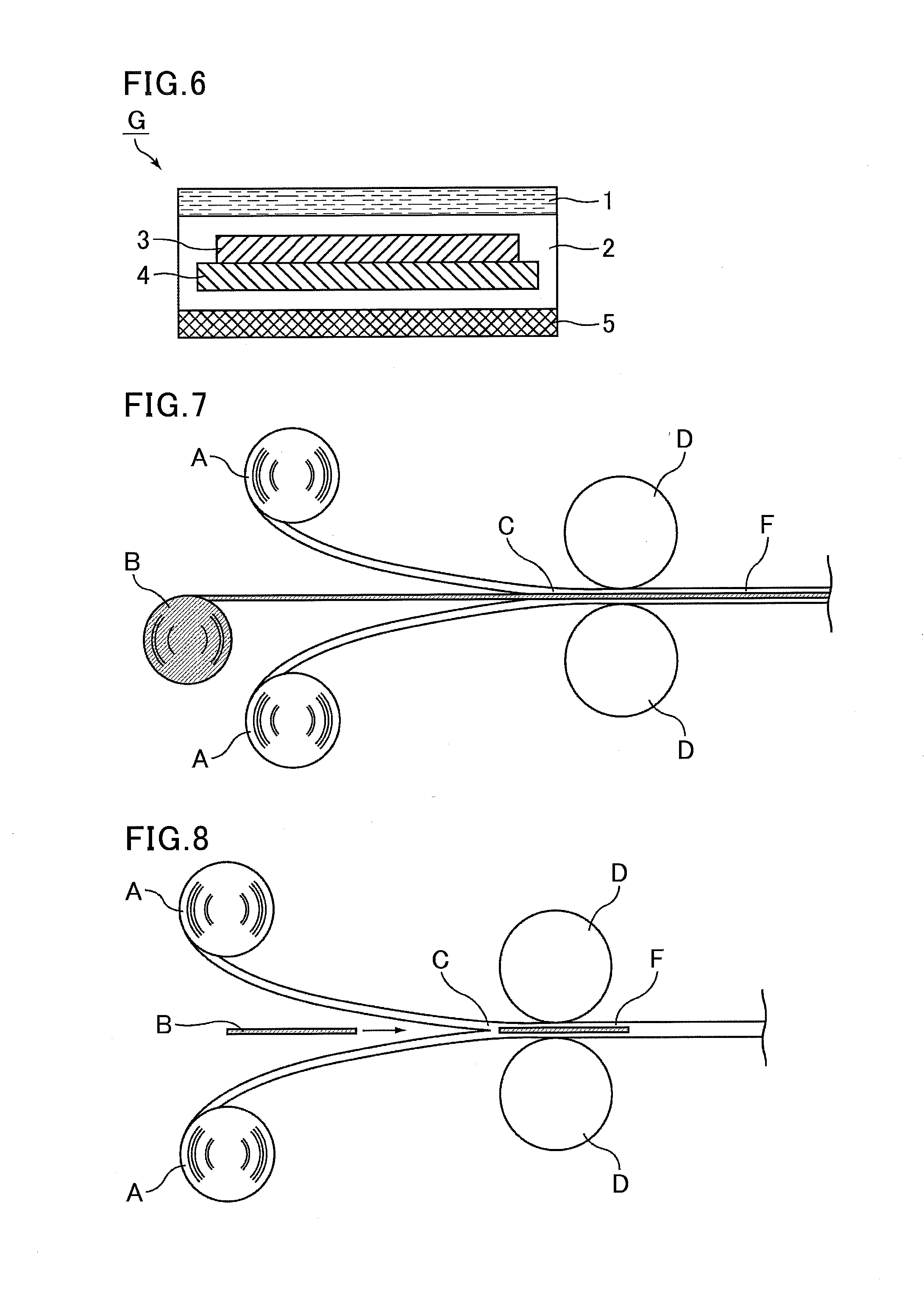Solar cell sealing sheet and flexible solar cell module
a solar cell module and solar cell technology, applied in the direction of film/foil adhesives, coatings, transportation and packaging, etc., can solve the problems of long time to finish bonding, use of eva resins, extended production time and generation of acid
- Summary
- Abstract
- Description
- Claims
- Application Information
AI Technical Summary
Benefits of technology
Problems solved by technology
Method used
Image
Examples
examples 1 to 21 , 23 to 29
Examples 1 to 21, 23 to 29, and Comparative Examples 4, 6, 7
[0138]An adhesive layer composition that contained 100 parts by weight of a modified butene resin in which a butene-ethylene copolymer containing predetermined amounts (shown in Tables 1 to 5) of butene units and ethylene units is graft-modified with maleic anhydride, and a predetermined amount (shown in Tables 1 to 5) of a silane compound selected from 3-glycidoxypropyltrimethoxysilane (trade name: “Z-6040”, available from Dow Corning Toray Co., Ltd.) and 3-acryloxypropyltrimethoxysilane (trade name: “KBM-5103”, available from Shin-Etsu Chemical Co., Ltd.) was molten and kneaded in a first extruder at 250° C.
[0139]Separately, a predetermined fluoropolymer shown in Tables 1 to 5 (polyvinylidene fluoride (trade name: “Kynar 720”, available from Arkema); tetrafluoroethylene-ethylene copolymer (trade name: “Neoflon ETFE”, available from Daikin Industries, Ltd.); polyvinyl fluoride resin (trade name: “Tedlar” available from Du ...
example 22
[0144]An adhesive layer composition that contained 100 parts by weight of a modified butene resin in which a butene-ethylene copolymer containing predetermined amounts (shown in Table 4) of butene units and ethylene units is graft-modified with maleic anhydride, and a predetermined amount (shown in Table 4) of 3-glycidoxypropyltrimethoxysilane (trade name: “Z-6040”, available from Dow Corning Toray Co., Ltd.) as a silane compound was molten and kneaded in a first extruder at 250° C. Separately, a predetermined fluoropolymer shown in Table 4 (polyvinylidene fluoride, trade name: “Kynar 720”, available from Arkema) was molten and kneaded in a second extruder at an extrusion temperature shown in Table 4. The adhesive layer composition and the fluoropolymer were supplied to a coalescent die connecting the first extruder and the second extruder where they were contacted. Subsequently, when the adhesive layer composition and the fluoropolymer were extruded from a T die connected to the co...
examples 30 to 34
[0162]A flexible solar cell module was produced in the same manner as in Example 1, except using an adhesive layer composition consisting of: 100 parts by weight of a modified butene resin in which a butene-ethylene copolymer including butene units and ethylene units in amounts shown in Table 6 is graft-modified with maleic anhydride; and, as a silane compound, an amount shown in Table 6 of 3-glycidoxypropyltrimethoxysilane (trade name: “Z-6040”, available from Dow Corning Toray Co., Ltd.), 2-(3,4-epoxycyclohexyl)ethyltrimethoxysilane (trade name: “Z-6043”, available from Dow Corning Toray Co., Ltd.), 3-glycidoxypropyltriethoxysilane (trade name: “KBE-403”, available from Shin-Etsu Chemical Co., Ltd.), 3-glycidoxypropylmethyldimethoxysilane (trade name: “KBM-402”, available from Shin-Etsu Chemical Co., Ltd.), or 3-glycidoxypropylmethyltriethoxysilane (trade name: “KBE-402”, available from Shin-Etsu Chemical Co., Ltd.). The obtained flexible solar cell module was evaluated for each i...
PUM
| Property | Measurement | Unit |
|---|---|---|
| Percent by mass | aaaaa | aaaaa |
| Percent by mass | aaaaa | aaaaa |
| Percent by mass | aaaaa | aaaaa |
Abstract
Description
Claims
Application Information
 Login to View More
Login to View More - R&D
- Intellectual Property
- Life Sciences
- Materials
- Tech Scout
- Unparalleled Data Quality
- Higher Quality Content
- 60% Fewer Hallucinations
Browse by: Latest US Patents, China's latest patents, Technical Efficacy Thesaurus, Application Domain, Technology Topic, Popular Technical Reports.
© 2025 PatSnap. All rights reserved.Legal|Privacy policy|Modern Slavery Act Transparency Statement|Sitemap|About US| Contact US: help@patsnap.com



